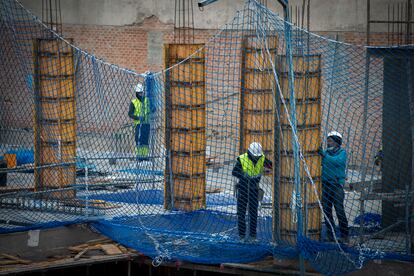Spain returns to pre-pandemic employment levels thanks to creation of 776,000 jobs in 2021
Figure marks biggest rise in occupation since 2005. There are 574,000 more workers signed up with Social Security and 140,000 fewer jobless than when Covid-19 hit

The latest data from the coronavirus pandemic in Spain shows that the virus is more widespread than ever. But for some time now, the country’s economy has been moving independently from the rhythm of Covid-19. In 2021, when four of the six waves of the health crisis were felt at varying levels, a total of 776,478 workers signed up with the Social Security system – considered a measure of job creation – while there were 782,232 fewer registered as unemployed. That’s according to the latest data, published on Tuesday by the Labor and Social Security ministries. Not since 2005 have so many jobs been created, when an extraordinary regularization of immigrants was carried out by the government, creating a statistical anomaly.
The disconnection between the health crisis and employment, which is now unquestionable after 10 consecutive months of falling unemployment, has been facilitated by the lifting of coronavirus restrictions, the advance of the vaccination campaign, and higher consumer spending levels thanks to the savings that households had accumulated during the pandemic.
These factors have allowed a recovery among workers with a speed that would have been unthinkable during previous recessions: in February 2020, the last month before the economic impact of Covid-19 was felt, there were 19,250,299 workers signed up with the Social Security system and 3,246,047 jobless. Currently, there are 19,824,911 workers signed up – an historic high – and 3,105,905 jobless.
The conclusion from this data is clear: right now, there are more people working and fewer jobseekers than there were before the news of a mysterious respiratory illness in the Chinese city of Wuhan made way for the biggest public-health challenge in a century. The pandemic not only finished a six-year cycle of falling unemployment, but it also put a series of tools to the test, such as assistance for the self-employed and the government’s ERTE furlough scheme.
In fact, of the 3.6 million people who were on the ERTE scheme in the spring of 2020, when Spain was in lockdown due to Covid-19, just 102,548 workers remain on the program – among these, a third of travel agency employees. At the close of December, there were also just over 20,000 workers on ERTEs for reasons not related to the virus. All of these people are registered as in work in the government data, and not as unemployed.
While Spain remains at the tail end of the European Union countries – along with Greece – in terms of percentage of unemployed, the end result compared to other crises is overwhelmingly favorable. After the Great Recession, it took 12 years to recover the number of people signed up to the Social Security system in the summer of 2007, which was also a time in Spain when the real estate boom was in full swing. In the wake of the pandemic, it only took a year to recover what was lost in 2020. From the low point of April of that year, when nearly a million jobs disappeared in just six weeks, nearly 1.4 million jobs had been recovered by December of 2021, approaching the symbolic barrier of 20 million contributors. In fact, the last month of the year – usually a time when seasonal hires are high due to the holiday season – was the icing on the cake of this process, with 72,553 more workers signed up to Social Security.

Registered unemployment is also recovering, and is not far from breaking the barrier of three million jobless. The figures have been falling for 10 months, which is the longest period in the historical series, and December closed with 76,782 fewer jobseekers – the lowest figure for that month since 2007 – thanks to the services sector.
As such, the labor market is giving the Spanish government the political capital it has not got from GDP, the other major indicator of the performance of the economy and a figure that is lagging behind not only employment, but also other European countries. The picture provided by GDP figures is even more confusing due to the unusual upward and downward revisions on the part of the National Statistics Institute (INE) given issues with the compilation of data.
In fact, the government is interpreting that employment data is sufficient to declare the economic crisis over. “The recovery is a fact,” stated the minister for the prime minister’s office, Félix Bolaños. The prime minister himself, Pedro Sánchez, was somewhat more restrained. “The data reflect once more the progress of recovery in Spain,” he said. “We will not be stopping. We will be working to combat precariousness and continue creating quality employment,” he wrote in a Twitter message.
There are a number of threats to the current cruising speed of employment. January, when Christmas spending winds down and a more austere period begins, is traditionally the worst month for Spain’s labor market. And this year, it will coincide with the ongoing explosion of coronavirus cases caused by the omicron variant. While the number of hospital admissions is so far proportionately lower than during other waves, the new strain is much more contagious than previous ones, something that has prompted the return of restrictions to sectors such as hospitality and nightlife in certain regions and other European countries, as well as regulations and recommendations to avoid events with crowds.
Tu suscripción se está usando en otro dispositivo
¿Quieres añadir otro usuario a tu suscripción?
Si continúas leyendo en este dispositivo, no se podrá leer en el otro.
FlechaTu suscripción se está usando en otro dispositivo y solo puedes acceder a EL PAÍS desde un dispositivo a la vez.
Si quieres compartir tu cuenta, cambia tu suscripción a la modalidad Premium, así podrás añadir otro usuario. Cada uno accederá con su propia cuenta de email, lo que os permitirá personalizar vuestra experiencia en EL PAÍS.
¿Tienes una suscripción de empresa? Accede aquí para contratar más cuentas.
En el caso de no saber quién está usando tu cuenta, te recomendamos cambiar tu contraseña aquí.
Si decides continuar compartiendo tu cuenta, este mensaje se mostrará en tu dispositivo y en el de la otra persona que está usando tu cuenta de forma indefinida, afectando a tu experiencia de lectura. Puedes consultar aquí los términos y condiciones de la suscripción digital.
More information
Últimas noticias
Welcome to the post-religion era: The idea of Christianity as the absolute truth has become obsolete
‘I thought you would like it’: The risky sexual practice popularized by TV shows and TikTok
The digitalization of tourism: ‘They promise experiences and gave us the worst possible one’
Mexican peso defies uncertainty with forecasts of a new period of stability in 2026
Most viewed
- Sinaloa Cartel war is taking its toll on Los Chapitos
- Reinhard Genzel, Nobel laureate in physics: ‘One-minute videos will never give you the truth’
- Oona Chaplin: ‘I told James Cameron that I was living in a treehouse and starting a permaculture project with a friend’
- Why the price of coffee has skyrocketed: from Brazilian plantations to specialty coffee houses
- Silver prices are going crazy: This is what’s fueling the rally











































